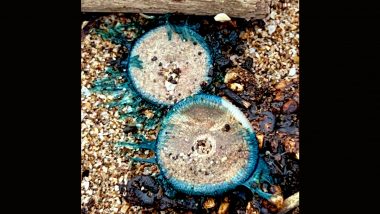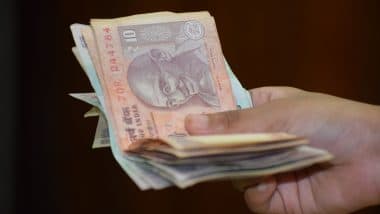Mumbai, August 31: There's no denying that Mumbai and Rain are a match made in heaven. And a rainy day walk on the Mumbai beaches is simply bliss. Strolling on the beach shore in the rainy season may seem like a good idea, but hold up. A familiar visitor has turned up on the beach. It's a blue button jellyfish. Recent heavy rains and strong winds from the sea have driven these venomous creatures onto Girgaon Chowpatty, posing a threat to beachgoers.
The vibrant blue button jellyfish, known for their striking colour and painful stings, have been frequent visitors to Mumbai’s shorelines. Indian Express reported that they were spotted at the Girgaon Chowpatty just ahead of Ganpati Visarjan. These marine creatures are commonly seen at Girgaon, Juhu, Versova, Aksa, and Dadar beaches during the monsoon season. Mumbai Coastal Road Closure: Dharmveer Swarajya Rakshak Chhatrapati Sambhaji Maharaj Coastal Road To Be Closed Partly From August 31 to September 2 for DG Electric Work, Check Details Here.
Blue Button Jellyfish
Porpita (blue button) pair on Mumbai’s shoreline. They’re related to jellyfish but not exactly jellyfish.
I call them… jelly-ish 😂🪼
Mildly toxic to touch, severely gorgeous to see! Monsoon seasonal in Mumbai.#MarineLifeofMumbai #IndiAves #NationalBeachDay pic.twitter.com/1sz7yjtKTl
— Sahir Doshi (@SahirDoshi) August 30, 2024
Blue Button Jellyfish on Mumbai Beaches
In the past few years, numerous tourists have suffered painful stings from these jellyfish. The blue button, named for its distinctive appearance, is one of three jelly-like organisms commonly found in Mumbai’s marine ecosystem. These include ‘Blue Buttons’ before the monsoon, ‘Blue Bottles’ during the monsoon, and ‘Box Jellies’ after the rains subside. The blue button's presence on Mumbai’s beaches has increased due to rising ocean temperatures and the abundance of food from marine debris.
How Dangerous Are Blue Button Jellyfish?
Despite appearing lifeless when washed ashore, blue buttons can still deliver painful stings through their venomous tentacles. Contact with these tentacles causes red spots, burns, and sometimes swelling and severe pain. Last year, six tourists were stung by jellyfish at Juhu Chowpatty. Mumbai: New Suburban Corridor Among 12 Rail Projects Underway in City, Says Railway Minister Ashwini Vaishnaw.
How to Treat Blue Button Jellyfish Sting?
Immediate medical treatment is essential for blue button stings. Victims should avoid rubbing the affected area and rinse it with seawater or warm water. Carefully remove any tentacles embedded in the skin and seek medical attention promptly. With proper treatment, pain and injuries typically subside within one to two hours.
A few measures can mitigate the risks associated with jellyfish blooms. It is crucial to educate the public about jellyfish risks, especially during bloom seasons. Regular monitoring of jellyfish populations and environmental conditions can help predict blooms. Early warnings based on this data can inform the public and manage beach access during high-risk periods.
(The above story first appeared on LatestLY on Aug 31, 2024 08:50 PM IST. For more news and updates on politics, world, sports, entertainment and lifestyle, log on to our website latestly.com).













 Quickly
Quickly




















